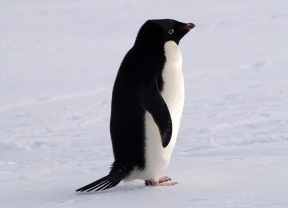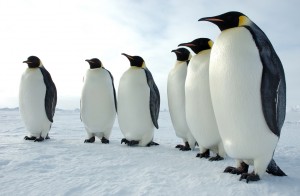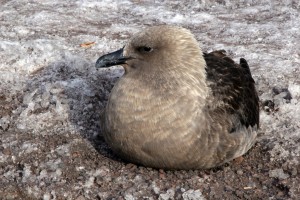Though penguins are the most well known, many species of birds call the Arctic and Antarctic home for at least part of the year. Skuas, petrels, Adelie penguins, and many other types of seabirds breed and raise their young in the polar regions during the summer months. Yet other species, such as the emperor penguin, the snowy owl, and the willow ptarmigan, remain in the polar regions throughout the year.

The Adelie penguin is a migrating bird. Photos courtesy of Patrick Rowe, National Science Foundation.

Birds that live in the polar regions year-round include the emperor penguin. Photo courtesy of Glenn Grant, National Science Foundation.
If you live in an area with cold, snowy winters, you know that January means piling on the coats, scarves, and gloves, and perhaps drinking a hot beverage. But how do birds that spend their winters in cold places stay warm? Packed into those birds are physical and behavioral adaptations to keep them provisioned throughout the year!
First, birds’ feathers provide a lot of insulation. You might have noticed birds “fluffing up.” They fluff their feathers to trap air between their feathers and bodies. The result is a natural layer of insulation, like a down sleeping bag. Also, when they sleep or rest, the birds tuck their bills under their wing feathers in order to breathe in this warmer air.
You may also notice many birds coming to your feeders when it is cold and snowy. Like mammals, birds are warm-blooded and have a high metabolic rate. In the winter especially, they must eat to maintain their heart rate and be able to shiver to maintain their body temperature. As in humans, the shivering generates warmth.
While a few birds, such as the willow ptarmigan, have feathers on their feet to help keep warm, many birds have naked feet. A countercurrent blood exchange in the feet helps keep the heat loss to a minimum while preventing frostbite (see the Complex Duck Feet section). A bird might also tuck one foot up under its feathers, balancing on only one leg!

A willow ptarmigan’s feathered feet help keep it warm and work as “snowshoes.” Photo courtesy of Jean-Guy Dallaire via Flickr.
Birds also might change behaviors in the cold. Besides eating more, some huddle together for warmth. Birds such as snow grouse may hide in a snow burrow for shelter and warmth.
Finally, while many people think migration is a way for birds to “escape the cold,” often the migration takes place to secure adequate food resources rather than to just stay warm. See the Migration: Should I Stay or Should I Go? section for more information.
Complex Duck Feet
A gull stands in icy water. Photo courtesy of Macaulay Library, Cornell Lab of Ornithology.
If you’ve ever seen a duck swimming along on a partially frozen pond or a gull standing on ice, you may have wondered how its feet don’t freeze! Those feet are not thick enough to have an insulating layer of fat, nor are they covered in feathers. The blood flows close to their skin, cooling rapidly in the freezing water. The problem for these birds is balancing the need to conserve body heat with the need to supply their legs and feet with enough oxygen, nutrients, and warmth. Consider humans: for us, frostbite is caused by severely reduced blood flow to our extremities in cold weather. Over extended periods, the tissues in our fingers and toes do not get warmth or nutrients from the blood and can die. One secret to avoiding this in ducks and gulls is their blood flow system, called “countercurrent exchange.”
Arterial blood leaves the bird’s core at a warm body temperature, while venous (returning) blood in the bird’s foot is quite cool. Some birds have circulatory patterns to reduce the heat lost through their feet when standing on ice or swimming in cold water. As cold blood runs up the leg from the foot and passes by the arteries, it picks up most of the heat from the arteries via conductance. As it travels, the blood flowing down is cooled, and the blood flowing up is warmed. Thus, by the time arterial blood reaches the foot, it is cool and does not lose too much heat in the cold water, and venous blood reaching the core has already been warmed, helping maintain core heat. Certain birds, such as gulls and waterfowl, have a specialized countercurrent heat exchanger located in their upper leg (see image). In these birds, blood flow is carefully regulated to maintain the delicate balance of providing blood but maintaining core body temperature. While the core temperature of a duck or gull standing on ice may be 104 degrees F, its feet may be only slightly above freezing.
Migration: Should I Stay or Should I Go?
When ornithologists speak of migration, they are usually referring to seasonal migration, or the large-scale, annual movement of all or part of a population between its breeding (summer) and nonbreeding (wintering) grounds. It’s a cycle that birds on every continent repeat each year, in response to the change in day length. Different bird species have different migration habits. The habits include everything from the journey of arctic terns (who travel halfway around the earth from Antarctica to their breeding grounds in far-northern Canada) to movements of blue grouse in the Northern Rockies (up mountainsides in the winter and back down to the valleys in the spring).
These movements are almost always based on the availability of food rather than “keeping warm.” Birds need to eat a lot to keep going; some species can eat up to 20 percent of their body weight daily. That’s like a 140-pound adult eating 28 pounds of food a day! Plus, birds need to find even more food when they’re feeding their young.
The need to feed and raise young is the main reason that many birds don’t just stay in the warm tropics year-round. Although the tropics have a favorable climate, they are also home to a huge number of birds competing for food. Leaving their tropical winter homes and flying north into the temperate region (the northern United States and Canada) offer birds the promise of a tremendous explosion of food sources, such as insects, which hatch in the spring and summer. Birds can take advantage of this seasonal supply of food to feed their young. It’s a balancing act, though, since migration itself is dangerous and increases a bird’s risk of death (see Table).
A Balancing Act
Some bird species stay in the same place year-round and either raise fewer young (tropical residents) or face higher death rates over the winter (temperate and polar residents). Migrants risk the perils of migration, but are able to raise their young in the food-rich temperate or polar region without having to spend the winter there.
|
Tropical Residents |
Migrants |
Temperate and Polar Residents |
|
High survival rate avoid hazards of migration and harsh winter weather |
Moderate survival rate due to hazards of migration |
Low survival rate due to cold and starvation |
|
Few young raised per year food for young is less abundant |
Moderate number of young raised per year due to abundant food in breeding areas |
May raise many young per year due to abundant food |
Thus, the primary advantage of migration is reproductive. The longer days of the northern summer provide greater opportunities for breeding birds to feed their young. The extended daylight hours and high food availability allow birds to produce larger clutches of eggs than related non-migratory species that remain in the tropics year-round. These advantages offset the high stress, energetic costs, and other risks of migration.
Links
Wildlife of Antarctica
Includes information on penguins and other birds found in Antarctica.
All About Birds
A wealth of information about birding, characteristics and behavior of birds, attracting birds, gear, and conservation.
All About Birds: Bird Guide
Learn about individual species through this interactive, online guide that includes images, maps, and sounds.
Arctic Studies Center: Birds
Information about six arctic species: albatross, bald eagle, peregrine falcon, ptarmigan, puffin, and snowy owl.
Birds in the Arctic Refuge
A brief article discusses the many migratory species that summer in the Arctic National Wildlife Refuge.
NATIONAL SCIENCE EDUCATION STANDARDS: SCIENCE CONTENT STANDARDS
The entire National Science Education Standards document can be read online or downloaded for free from the National Academies Press web site. The following excerpt was taken from Chapter 6.
A study of birds aligns with the Life Science content standards of the National Science Education Standards. In grades K-4, students focus on the characteristics and life cycles of organisms and the way in which organisms live in their environments. Students in grades 5-8 expand on this understanding by focusing on populations, communities of species, and the ways they interact with each other and with their environment.
Teaching about birds can meet a wide variety of fundamental concepts and principles, including:
K-4 Life Science
- The Characteristics of Organisms
- Life Cycles of Organisms
- Organisms and Their Environments
5-8 Life Science
- Reproduction and Heredity
- Regulation and Behavior
- Populations and Ecosystems
- Diversity and Adaptations of Organisms
This article was written by Jennifer Fee. For more information, see the Contributors page. Email Kimberly Lightle, Principal Investigator, with any questions about the content of this site.
Copyright February 2009 – The Ohio State University. This material is based upon work supported by the National Science Foundation under Grant No. 0733024. Any opinions, findings, and conclusions or recommendations expressed in this material are those of the author(s) and do not necessarily reflect the views of the National Science Foundation. This work is licensed under an Attribution-ShareAlike 3.0 Unported Creative Commons license.









